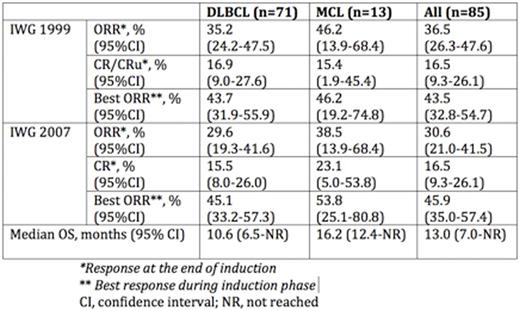Abstract
BACKGROUND: the combination of rituximab (RTX) and lenalidomide (LEN) has been shown to be synergistic in pre-clinical models and in patients (pts) with previously untreated and relapsed follicular lymphoma (FL). Furthermore, LEN demonstrated single agent efficacy in pts with mantle cell lymphoma (MCL) and diffuse large B cell lymphoma (DLBCL). We hypothesized that the combination of obinutuzumab (GA), a glycoengineered type II anti-CD20 antibody, with LEN (GALEN) might be even more efficient while retaining a similarly manageable safety profile. In 2012, we started a phase Ib/II study to assess the safety and efficacy of this combination (ClinicalTrials.gov: NCT01582776) in pts with relapsed/refractory lymphoma. Phase IB defined the recommended dose (RD) of LEN as being 20mg in combination with GA. Here, we report the results of the Phase II part assessing efficacy and safety of GALEN therapy during a 6 months induction followed, for responders, by a reduced LEN maintenance GALEN regimen (in a cohort of relapsed/refractory aggressive NHL (DLBCL or MCL) pts.
METHODS: pts with a histologically confirmed DLBCL (de novo or transformed low-grade NHL) or MCL were eligible if they had a ECOG PS of ²2, a life expectancy >3 months (mo) and had previously received ³1 prior therapy including at least one RTX-containing regimen. Induction treatment consisted of LEN 20 mg given orally once daily on days 1-21 of a 28-day cycle for the first cycle and on days 2-22 of a 28-day cycle from cycles 2 to 6. Intravenous infusions of GA were given at a flat dose of 1000mg on days 8, 15, and 22 of cycle 1 and at D1 of cycles 2 to 6 (total of 8 infusions). Responding pts then received 12 cycles of LEN at 10 mg daily on days 2-22 every 28 days for a total of 18 cycles and GA 1000mg every 8 weeks for 12 additional cycles until progression or unacceptable toxicity. All pts were required to take daily aspirin (100 mg) for deep vein thrombosis (DVT) prophylaxis during study period. Pts who were unable to tolerate aspirin and had a prior history of DVT or were at high risk for a DVT received low molecular weight heparin therapy or warfarin (coumadin) treatment. The primary study endpoint was overall response rate (ORR) by investigator assessment at the end of induction according to 1999 IWG criteria. Secondary endpoints included ORR and complete response (CR) according to IWG 2007, best ORR, duration of response, progression-free survival, overall survival (OS) and safety.
RESULTS: ninety-one pts (DLBCL [n=77 including 18 transformed], MCL [n=13], and other [n=1]) were enrolled between June 2014 and March 2015 at 22 LYSA centers in France and Belgium. At baseline, median age was 70 (range, 48-84) years with 64.7% men, ECOG PS of 1 (47.1%) or 2 (18.8%), 83.5% Ann Arbor stage III-IV and 66.3% with elevated LDH. Median number of prior systemic therapies was 2 (range, 1-9) including haematopoietic stem cell transplantation in 17pts (20%); 61% were refractory to a RTX-containing regimen and 53% refractory to last prior therapy. Three pts were withdrawn before receiving any treatment due to major protocol violation, concurrent illness or ulceration of the tumor in the stomach and 3 pts received one of both study drugs, leaving 85 pts assessable for efficacy. Cut-off date was March 25th 2016. With amedianfollow-up of 14.5 mo,39pts (45.8%) completed induction (32 DLBCL and 7 MCL) and 20 (23.5%) are still ongoing in maintenance (16 DLBCL, 4 MCL). At the time of the cut-off, 44pts (51.8%) had died mainly due to lymphoma (88.6%). Response at the end of induction, best ORR during induction and OS are summarized in the table.
Table
Analysis of other secondary endpoints and correlation with cell of origin is ongoing. The most common treatment emergent AEs during induction (all grades >10%pts/ % grade 3/4) were neutropenia (51.1/31.8), infections (45.5/12.5), constipation (30.7/0.0), cough (21.6/1.1), diarrhea (17.0/3.4), nausea (17.0/0) anemia (15.9/10.2), thrombocytopenia (15.9/10.2), muscle spasms (13.6/0.0), fatigue (12.5/1.1) and dyspnea (11.4/4.5). Febrile neutropenia occurred in 4.5% pts. There was onlyone secondprimary malignancy (basal carcinoma).
CONCLUSION: oral LEN plus GA infusion is effective in relapsed or refractory DLBCL and MCL pts with no unexpected toxicity. Longer follow-up and additional translational studies are needed to identify the subset of pts most benefiting of this regimen. Correlative studies will be presented at the meeting.
Morschhauser:celgene: Honoraria, Membership on an entity's Board of Directors or advisory committees; roche: Honoraria, Membership on an entity's Board of Directors or advisory committees; servier: Consultancy, Honoraria; gilead: Consultancy, Honoraria; janssen: Honoraria. Cartron:Roche: Consultancy, Honoraria; Celgene: Honoraria; Gilead: Honoraria; Jansen: Honoraria. Salles:Janssen: Consultancy, Honoraria; Amgen: Consultancy, Honoraria; Celgene: Consultancy, Honoraria; Gilead: Honoraria, Research Funding; Mundipharma: Honoraria; Novartis: Consultancy, Honoraria; Roche/Genentech: Consultancy, Honoraria, Research Funding. Maerevoet:ARGN-X: Membership on an entity's Board of Directors or advisory committees; roche: Membership on an entity's Board of Directors or advisory committees; BMS: Membership on an entity's Board of Directors or advisory committees. Bonnet:ROCHE: Membership on an entity's Board of Directors or advisory committees; SERVIER: Membership on an entity's Board of Directors or advisory committees; BMS: Membership on an entity's Board of Directors or advisory committees; JANSSEN: Membership on an entity's Board of Directors or advisory committees.
Author notes
Asterisk with author names denotes non-ASH members.


This feature is available to Subscribers Only
Sign In or Create an Account Close Modal